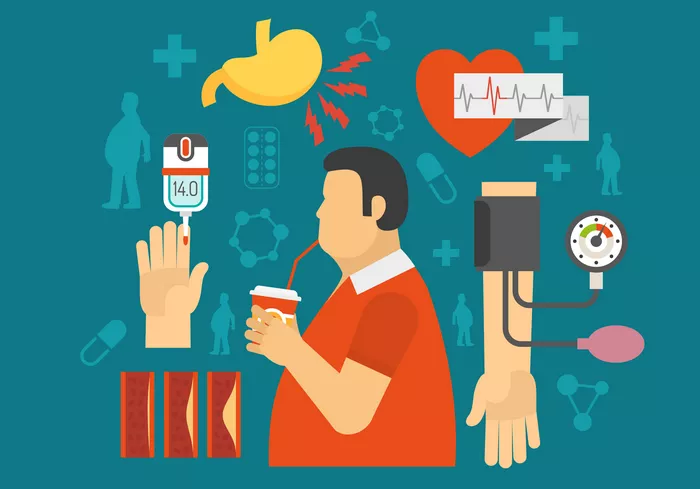Borderline type 2 diabetes, often referred to as prediabetes, is a crucial stage in the continuum of diabetes care. This condition serves as a warning sign, indicating that an individual is at risk of developing type 2 diabetes and its associated complications. Understanding borderline type 2 diabetes is essential for early intervention and effective management. This article explores the definition, risk factors, symptoms, diagnostic criteria, management strategies, and potential complications associated with borderline type 2 diabetes.
Understanding Borderline Type 2 Diabetes
Definition of Borderline Type 2 Diabetes
Borderline type 2 diabetes is characterized by elevated blood glucose levels that are higher than normal but not high enough to be classified as diabetes. This condition signifies an intermediate state of insulin resistance and glucose intolerance, often leading to full-blown type 2 diabetes if left unmanaged.
Importance of Early Detection
Identifying borderline type 2 diabetes is critical because it provides an opportunity for lifestyle modifications and medical interventions that can prevent or delay the progression to type 2 diabetes. Early detection can significantly impact an individual’s long-term health outcomes and reduce the risk of developing serious complications.
Risk Factors for Borderline Type 2 Diabetes
Several risk factors contribute to the development of borderline type 2 diabetes. Understanding these factors is vital for identifying at-risk individuals and implementing preventive strategies.
Obesity and Overweight
Excess body weight, particularly abdominal obesity, is one of the most significant risk factors for developing borderline type 2 diabetes. Adipose tissue, especially visceral fat, releases inflammatory substances that can lead to insulin resistance.
Physical Inactivity
A sedentary lifestyle contributes to weight gain and insulin resistance. Regular physical activity helps improve insulin sensitivity and maintain a healthy weight.
Family History
A family history of type 2 diabetes increases the likelihood of developing borderline type 2 diabetes. Genetics plays a crucial role in insulin resistance and glucose metabolism.
Age
The risk of developing borderline type 2 diabetes increases with age, particularly for individuals over 45 years old. Aging is often associated with increased body fat and decreased muscle mass.
Ethnicity
Certain ethnic groups, including African Americans, Hispanic Americans, Native Americans, and Asian Americans, are at a higher risk for developing type 2 diabetes and borderline conditions.
High Blood Pressure
Hypertension is often associated with metabolic syndrome and increases the risk of developing borderline type 2 diabetes.
Abnormal Cholesterol Levels
Dyslipidemia, characterized by high triglycerides and low HDL cholesterol levels, is linked to insulin resistance and an increased risk of diabetes.
Gestational Diabetes
Women who have experienced gestational diabetes during pregnancy are at a higher risk of developing borderline type 2 diabetes later in life.
Polycystic Ovary Syndrome (PCOS)
PCOS is associated with insulin resistance, making women with this condition more susceptible to developing borderline type 2 diabetes.
Unhealthy Dietary Habits
A diet high in refined carbohydrates, sugars, and unhealthy fats can contribute to obesity and insulin resistance, increasing the risk of borderline diabetes.
Symptoms of Borderline Type 2 Diabetes
Individuals with borderline type 2 diabetes may not exhibit significant symptoms, making routine screening essential. However, some early warning signs may indicate the presence of this condition.
Increased Thirst
Frequent thirst can be a sign of elevated blood sugar levels, prompting the kidneys to work harder to eliminate excess glucose through urine.
Frequent Urination
Increased urination is another potential symptom, as the body attempts to excrete excess glucose, leading to dehydration.
Fatigue
Individuals may experience fatigue and low energy levels due to the body’s inability to effectively utilize glucose for energy.
Blurred Vision
High blood sugar levels can affect the lenses of the eyes, leading to temporary blurred vision.
Slow-Healing Wounds
Prediabetes can impair the body’s ability to heal wounds and fight infections, leading to slower recovery times.
Darkened Skin Patches
Acanthosis nigricans, characterized by dark, velvety patches of skin, often appears in body folds and is associated with insulin resistance.
Diagnostic Criteria for Borderline Type 2 Diabetes
Diagnosing borderline type 2 diabetes involves assessing various blood glucose levels and conducting specific tests. The following criteria are commonly used:
Fasting Plasma Glucose (FPG)
A fasting plasma glucose level between 100 mg/dL and 125 mg/dL (5.6 to 6.9 mmol/L) indicates borderline type 2 diabetes. This test measures blood sugar levels after an overnight fast.
Oral Glucose Tolerance Test (OGTT)
The OGTT involves measuring blood glucose levels two hours after consuming a glucose-rich beverage. A result between 140 mg/dL and 199 mg/dL (7.8 to 11.0 mmol/L) is indicative of borderline type 2 diabetes.
Hemoglobin A1c (HbA1c)
The HbA1c test provides an average blood sugar level over the past two to three months. A result between 5.7% and 6.4% indicates borderline type 2 diabetes.
Random Plasma Glucose Test
A random plasma glucose level of 200 mg/dL (11.1 mmol/L) or higher, along with symptoms of diabetes, may also suggest borderline type 2 diabetes.
Management Strategies for Borderline Type 2 Diabetes
Managing borderline type 2 diabetes involves lifestyle modifications, regular monitoring, and, in some cases, medication. Early intervention can significantly delay or prevent the onset of type 2 diabetes.
Lifestyle Modifications
Healthy Diet
A balanced diet is crucial for managing blood sugar levels. Key dietary recommendations include:
- Increase Fiber Intake: Incorporate whole grains, fruits, vegetables, and legumes to improve insulin sensitivity and stabilize blood sugar levels.
- Limit Processed Foods: Reduce the consumption of sugary snacks, beverages, and processed foods that can spike blood glucose levels.
- Portion Control: Practice portion control to manage calorie intake and prevent weight gain.
- Healthy Fats: Choose healthy fats such as olive oil, avocados, and nuts while avoiding trans fats and saturated fats.
Regular Physical Activity
Engaging in regular physical activity helps improve insulin sensitivity and maintain a healthy weight. Recommendations include:
- Aerobic Exercise: Aim for at least 150 minutes of moderate-intensity aerobic exercise per week, such as brisk walking, cycling, or swimming.
- Strength Training: Incorporate strength training exercises at least two days a week to build muscle mass and improve metabolic health.
Weight Management
Achieving and maintaining a healthy weight is essential for managing borderline type 2 diabetes. Even a modest weight loss of 5-10% can significantly improve insulin sensitivity and reduce the risk of developing type 2 diabetes.
Regular Monitoring
Regular monitoring of blood glucose levels is vital for tracking progress and making necessary adjustments to management strategies. Individuals with borderline type 2 diabetes should:
- Monitor Blood Sugar Levels: Regularly check blood sugar levels as recommended by a healthcare provider to assess the effectiveness of lifestyle modifications.
- Regular Check-ups: Schedule regular appointments with a healthcare provider to monitor overall health, assess risk factors, and receive guidance on managing borderline diabetes.
Medication Management
In some cases, healthcare providers may recommend medication to help manage blood sugar levels and reduce the risk of developing type 2 diabetes. Common medications include:
- Metformin: Often prescribed to individuals with borderline type 2 diabetes to improve insulin sensitivity and lower blood sugar levels.
- GLP-1 Receptor Agonists: These medications help regulate blood sugar levels and promote weight loss by increasing insulin secretion and reducing appetite.
- SGLT2 Inhibitors: These drugs work by preventing glucose reabsorption in the kidneys, leading to increased glucose excretion in urine.
Education and Support
Education about borderline type 2 diabetes and its implications is crucial for effective management. Individuals should seek resources and support from:
- Diabetes Educators: Engage with certified diabetes educators who can provide personalized guidance on managing blood sugar levels and making healthy lifestyle choices.
- Support Groups: Join diabetes support groups to connect with others facing similar challenges and share experiences and tips for management.
Potential Complications of Borderline Type 2 Diabetes
Individuals with borderline type 2 diabetes are at risk of developing various complications if the condition is not managed effectively. Understanding these potential complications is essential for motivating individuals to take proactive steps toward their health.
Progression to Type 2 Diabetes
The most significant risk associated with borderline type 2 diabetes is the progression to full-blown type 2 diabetes. Without intervention, the likelihood of developing diabetes increases significantly over time.
Cardiovascular Disease
Individuals with borderline type 2 diabetes are at a higher risk of developing cardiovascular disease, including heart attacks and strokes. Factors such as obesity, hypertension, and dyslipidemia contribute to this increased risk.
Kidney Disease
Prediabetes can lead to chronic kidney disease (CKD) due to elevated blood sugar levels damaging the kidneys over time. Early detection and management are crucial in preventing kidney complications.
Neuropathy
Borderline type 2 diabetes can lead to diabetic neuropathy, characterized by nerve damage resulting in pain, numbness, or tingling in the extremities.
Vision Problems
High blood sugar levels can lead to retinopathy and other vision problems, increasing the risk of blindness if left untreated.
Skin Conditions
Individuals with borderline type 2 diabetes may be prone to various skin conditions, including fungal infections and acanthosis nigricans.
See also: What a Diabetic Patient Should Avoid
Conclusion
Borderline type 2 diabetes serves as a critical warning sign for individuals, indicating an increased risk of developing type 2 diabetes and associated complications. Understanding the definition, risk factors, symptoms, diagnostic criteria, management strategies, and potential complications of borderline type 2 diabetes is essential for effective intervention.
Early detection and proactive management through lifestyle modifications, regular monitoring, and, when necessary, medication can significantly delay or prevent the progression to type 2 diabetes. It is crucial for individuals to remain informed and engaged in their health to ensure long-term success in managing borderline type 2 diabetes and reducing the risk of serious health complications. By taking these steps, individuals can pave the way for a healthier future and improve their overall quality of life.
Related topics:
What Does Diabetes Remission Mean?



























